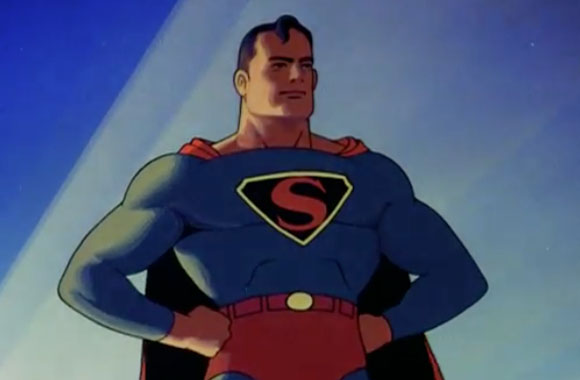Superhero Sundays: The Best of The Complete Animated Superman (1941)
Review Overview
Gorgeous animation
8Super-action
8Wanton destruction
8Matthew Turner | On 31, Mar 2019
Director: Dave Fleischer
Cast: Bud Collyer, Joan Alexander, Julian Noa, Jack Mercer, Jackson Beck
Certificate: PG
Watch The Complete Animated Superman (1941) online in the UK: TPTV Encore
On Sunday mornings, we like to watch cartoons. So we’re working our way through animated DC superhero cartoons on Amazon Prime Video UK. We call it Superhero Sundays.
In 1941, Paramount Pictures acquired the rights to Superman from creators Jerry Siegel (credited as Jerome here) and Joe Shuster. They subsequently pitched a Superman series to their animation producers, Fleischer Studios, headed up by Max Fleischer (creator of Betty Boop) and his younger brother, Dave. Handed an unusually high budget (Dave Fleischer originally didn’t want to do the cartoons and gave Paramount a ridiculously high estimate he thought they’d refuse), Fleischer Studios set about producing the series with the same high production values they’d established with their first feature film, Gulliver’s Travels (1939). As a result, the attention to detail in the series is extraordinary, with elaborate special effects sequences and striking use of colour and shadow.
The series ran for 17 episodes (like the Warner Bros. cartoons, they were typically shown in cinemas before the main feature) and proved extremely influential for future DC animators. In particular, Bruce Timm drew on Fleischer’s vintage colour scheme and film noir approach for Batman: The Animated Series, as well as including tributes and direct lifts in various episodes.
In terms of Superman lore, the series is endlessly fascinating. Although Ma and Pa Kent had been introduced in the comics in 1939, they are absent from the animated series – instead a “passing motorist” finds the Super-baby and leaves him with an orphanage. In fairness, that all happens in the introductory prologue (along with a green-glowing Krypton exploding and a baby being sent to Earth), with the main stories all taking place while Superman is working at the Daily Planet.
There are a few other things to note too. For one thing, the series carries on many of the associated phrases that originated on the radio show in February 1940. These include “Up, in the sky, look! It’s a bird! It’s a plane! It’s Superman!”, as well as “Faster than a speeding bullet, more powerful than a locomotive, able to leap tall buildings in a single bound” and “This looks like a job for SUPERMAN!” In addition, the series cast the radio actors as the voices of Superman / Clark Kent (Bud Collyer), Lois Lane (Joan Alexander) and Perry White (Julian Noa), whose character was originally created for the radio show.
Though it’s fair to say that there’s not a lot of variety in the plots (pretty much every story can be summed up with ‘Lois gets in a scrape and Superman saves her’), every episode is worth watching, especially as none of them are over 10 minutes long. Below, we’ve picked our five favourite.
Episode 1 – The Mad Scientist
Also known simply as Superman, the pilot episode sets the template for the rest of the series. Here, the titular Mad Scientist (Jack Mercer, who also voiced Popeye and Felix the Cat) is threatening to destroy Metropolis with his Electrothanasia-Ray. Lois, already a strong, fearless character, sets off to investigate and flies a private plane to the scientist’s lair, where she’s promptly captured after the villain’s pet bird (who looks like a parrot-vulture hybrid) alerts him to her presence. The scientist unleashes his destructo-ray and destroys a bridge, but it isn’t until he aims the thing at the Empire State Building that Clark declares, “This looks like a job for Superman!” He then puts the building back in place as it’s about to topple over and there’s a great bit where he basically PUNCHES the destructo-ray over and over again as he tracks it to its source. The episode makes great use of shadow and is further enhanced by Sammy Timberg and Winston Sharples’ exciting theme music. It ends, like most of the episodes, with Clark winking to the camera, as Lois, back at The Daily Planet, makes a comment about Superman. A fun piece of trivia: the pilot episode was nominated for the 1942 Academy Award for Best Short Subject (Cartoons), but it lost to a Pluto cartoon (Lend a Paw).
Episode 2 – Mechanical Monsters
The second episode sees the Man of Steel facing off against an army of bamk-robbing robots controlled by another mad scientist. The Daily Planet announces a museum exhibition where 50 million dollars of the world’s rarest gems will be displayed, so, naturally, the robots attack. However, rather than tackle them immediately, Clark instead phones in the story to the Daily Planet, leaving Lois (who is, throughout the series, arguably more heroic than Superman) to stow away in one of the robots by jumping into its storage container. Clark uses the phone booth to change into Superman (a highly influential moment that originated with this episode) and flies after Lois, using his X-ray vision to find her. This is, sadly, the only example of Superman using his X-ray vision in the Fleischer shorts, which is a shame, because the animation effect is really great, if a little bit creepy. Other great moments in the episode include: a spectacular death trap, with Lois being suspended above a vat of boiling metal; a terrific battle between Superman and 27 robots (they’re numbered), all of which have the ability to shoot fire; and an exciting moment where Superman uses his cape to shield Lois from a shower of molten metal. Phew.
Episode 3 – Billion Dollar Limited
The third episode of the series is a terrific showcase for both Superman and Lois. The plot involves a billion dollars in gold being shipped to the US mint, via steam train. Lois tags along on the train to cover the story and, sure enough, it’s attacked by a gang of thieves. When the engineer and the guard accidentally fall off the train along with two of the thieves, Lois climbs into the engine’s cab and not only seizes the controls of the train, but she also picks up a machine gun and fires at the robbers, who are driving alongside in a car. When the train hurtles out of control, Clark is alerted to Lois’ plight after overhearing a telegraph message at the Daily Planet. The ensuing train rescue is genuinely exciting (Dave Fleischer really knows how to stage an action sequence) and gives a real sense of Superman using his super-strength. The highlight is a spectacular bridge collapse, during which Superman catches the train in mid-air and places it back on the track. After the engine is derailed, he later pulls the entire train himself (surely pushing it would have been easier?), as the crooks hurl cans of tear gas and fire machine guns at him until he passes them. More powerful than a locomotive, indeed.
Episode 4 – The Arctic Giant
The fourth episode is essentially a Superman vs Godzilla story, before there was a Godzilla. As the narrator (Jackson Beck) explains, an arctic giant has been found in perfect condition, frozen in Siberia. Still encased in ice, it’s shipped to the Museum of Natural Science, where it’s labelled a Tyrannosaurus, even though it looks nothing like a Tyrannosaurus. Lois heads to the museum to cover the story, when she finds out that if the ice were to melt, it might turn out that the creature is still alive. Sure enough, an accident causes the refrigeration machine to stop working and the creature defrosts, whereupon it starts stomping all over Metropolis. Interestingly, the episode has the monster breaking a high-walled dam, which then floods the village below, in a scene that’s almost identical to the famous sequence in Richard Donner’s Superman (1978). It has to be said that the Fleischer cartoons are really big on destruction – some of it is genuinely shocking. Sadly, Superman’s actual battle with the monster is a bit dull (he mostly resorts to tripping it up with things), but there’s a great bit where Lois ends up in the monster’s mouth after trying to snap a photo and Superman has to rescue her before she gets eaten. Incidentally, if you like this episode, check out Terror on the Midway (Episode 9), which pits Superman against a giant gorilla (though it’s more of an escaped-from-the-circus kind of thing than the full King Kong).
Episode 12 – Eleventh Hour
This is a very strange episode that sees Superman working as a saboteur against the Japanese during the war. The story begins, randomly, with Superman destroying Japanese ships in the city of Yokohama. It turns out that Lois and Clark have both been interned as prisoners of war and Superman is sneaking out every night to smash stuff up for Uncle Sam. Eventually the Japanese get wise to his presence and post notices saying that if he doesn’t stop, “the American Girl Reporter will be executed at once”. Except Superman doesn’t see the notice, because he’s too busy destroying another ship. Sure enough, Lois is brought before a firing squad (heroic as ever, she doesn’t even so much as flinch) and Superman arrives just in time to shield her from a hail of bullets. All the same, it’s pretty dark stuff. Given that America had entered the war by December 1941, it’s no surprise that a number of cartoons in the series were given over to propaganda, although none of them are as weird as Jungle Drums (Episode 15), which somehow combines a Nazi submarine plot with Lois getting captured by jungle natives and features a cameo appearance from Adolph Hitler, looking disappointed as he learns Superman has foiled his latest plot.
The Complete Animated Superman is available on TPTV Encore, the free Talking Pictures TV catch-up service. Find out more here.




















